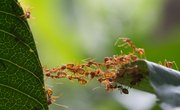
Hermit crabs are shelled animals found in the ocean and near the shore. The animals are also popular household pets. Many school age children use hermit crabs in science fair projects for a biology-based exhibit. Most projects require a few weeks of research before the actual fair, since crabs move slowly and need to be observed over a period of time before significant change happens.
Diet
Research what hermit crabs eat in the wild. Hermit crabs are scavengers, foraging for plant and animal remains; fish and vegetables are common menu items. Research what is in a typical hermit crab diet in captivity; hermit crab food is available in most pet stores and ingredients are listed on the label. Compare the natural and captivity diets to discover differences and similarities. Research additives to hermit crab food and reasons the additives are necessary. Compare the lists on poster board for presentation at a science fair and highlight which is better for hermit crabs, natural food or artificial food.
Changing Shells
Hermit crabs change shells frequently. Discover how often a crab changes a shell through this experiment. Place a variety of shells of different sizes in the tank; each shell will be numbered or otherwise marked to make each shell unique. Observe the hermit crab every day and record what shell he is using. When he changes shells, mark the change and take pictures. After weeks of observation, note how often the crab changes shells. Use the pictures taken after each change to create a poster. Write the date of the change on each picture and place them in chronological order.
Response to Changes in Light
Hermit crabs are nocturnal animals. Discover whether they can change to diurnal activity through this experiment. Observe the animal's activity in natural daylight. Gradually change the light so the habitat is artificially lit at night by leaving a light on for a few hours after dark and covering the cage for a few hours after sunrise. Observe the crab's behavior and response to the change in light from natural to artificial. Create a calendar which charts the animal's activities during the switch from natural to artificial light for the science fair.
Races
Purchase a few hermit crabs, label the shells to make the crabs unique, and allow them to race on a safe surface where they will not fall off an edge and crack their shells. Draw a starting line three feet from a finish line and encourage crabs to move by placing food or water at the finish line. Conduct races between different sized crabs to review how crabs move at different sizes. Record the difference in speeds and determination to reach the goal and display the results at the fair using a graph or table comparing race times for each crab.
References
About the Author
Rebecca Mayglothling has worked directly with toddlers and preschoolers for more than three years. She has published numerous lesson plans online as well as parenting and teaching advice. She continues to keep ahead of parenting methods and is eager to share them through her professional writing.
Photo Credits
Jeffrey Hamilton/Lifesize/Getty Images
